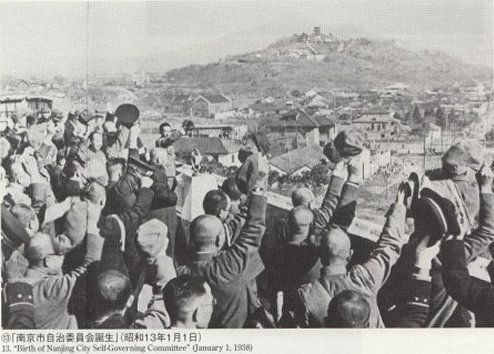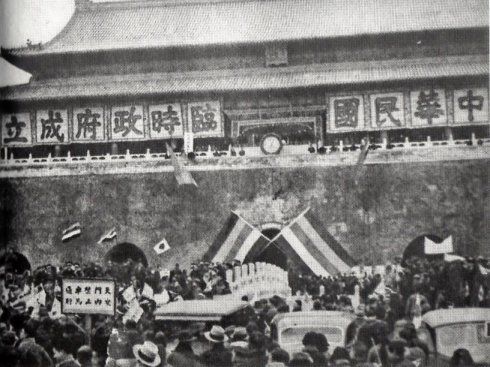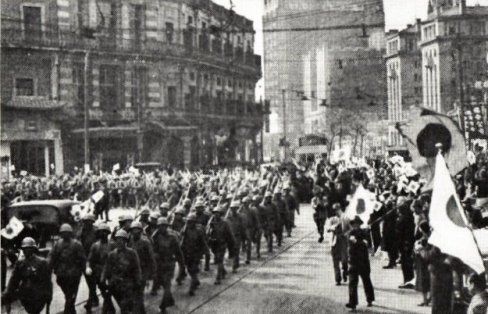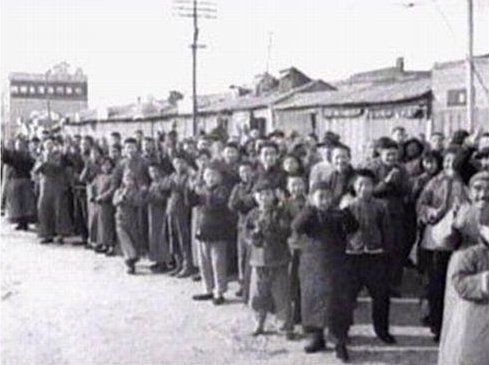by Moguro Fukuzo
Yokohama Japan
Yokohama Japan
C O N T E N T S
- Open Message from the Author
- Photo Gallery (photos taken just after the fall of Nanking)
- Recommended Youtube Videos
- Lies of the Rape of Nanking by Iris Chang
- What is the real number?
- Documents of the Nanking Safety Zone
- Liar, Liar, Pants on Fire
- Video: Fake of Nanking
- Shanghai Black Saturday "Crying Baby" Staged Photo
- Tactical Absurdity of the Nanking Massacre

- Maps and Chronology of Events
- The Documentary Film "Nanking"
- Is UNESCO a propaganda machine of PRC?

* * * *
Mao would often hark back with great bitterness to that December 1937 when Wang Ming prevailed. This stands in stark contrast to the fact that not once in his long life did he mention another event that took place at exactly the same time - a huge massacre in Nanjing, in which an estimated up to 300,000 Chinese civilians and prisoners of war were slaughtered by the Japanese. Mao never made any comment, then or later, about this, the single biggest human tragedy of the Sino-Japanese War for his fellow countrymen.
______________________________________
Japanese troops brutally killed 300,000 men, women and children in Nanking. Japanfs wartime atrocities are still in our memory.
- CCP President Xi Jinping
_________________________________________
China spreads lies such as Nanking Massacre and continually creates border conflicts with neighboring countries. China is not qualified to become the world leader.
Li Denghui - former president of Taiwan
______________________________________________
Open Message from the Author
Demonizing the enemy is commonplace during a war. But demonizing Japan still goes on in 21st century.
It is well known that the CCP (Chinese Communist Party) is the main source of Nanking Massacre propaganda despite the fact that it was KMT (Kuo-ming-tang) the Japanese forces fought during the Sino-Japanese War of 1937-1945.
(KMTfs official military records written by General He Yinqin describe in details military actions engaged by both KMT forces and Japan's Central China Front Force lead by General Matsui Iwane about the fall of the city. However, the same records do NOT comment on any mass-killing of civilians or prisoners of war. If mass-killing of 300,000 people actually took place, the KMTfs official military records should have pointed out the atrocity. It seems quite awkward and you would wonder why NO such information is written in the records.««)
(Source: p82, ‰½ã«RíŠúŠÔŒRŽ–•ñ@•¶¯‘“X@1962, Taiwan)
General He Yinqin was called the right-hand man of Chiang Kai-Shek, the head of the KMT forces.
The author of this webpage wonders why the CCP officials constantly come up with gJapanfs Atrocitiesh in todayfs diplomatic scenes so often. Are they doing so out of the desire to criticize the Japanese peoplefs general lack of remorse, guilt or self-hate from the perspective of humanity?
Humanity! The CCP, the evil dictatorship, a group of murderers, thieves, robbers, liars or tale-bearers, the oppressor of Uyghur and Tibet and their own people, wants to talk about HUMANITY!
CERTAINLY, YOU ARE KIDDING ME !!
Jian Zemin, the former president of the CCP, tortured and killed many innocent Falun Gong practitioners.
REMEMBER THAT THEY ARE MASTER PROPAGANDISTS !!
Cultural Revolution was in essence the power struggle among the top echelon of the CCP. However, the ordinary people, instigated by the demagogues, lend themselves to violence, humiliated, tortured, and killed their village leaders.
Diverting people's attention from their own failings is corwardice act of the CCP
The author believes that the CCP in truth wants to stoke up the fire of hatred in peoplefs mind in order to create a common enemy; make the Chinese people band together against the common enemy; and thereby ward off the criticism of the people to their own failures through the blame-shifting manipulation.
By the way, there is one thing the CCP did not know. Along with General Matsuifs Amy, 120 newspaper reporters and camera crews of various movie producing companies entered the city and there are many photos taken in the city just after the fall of Nanking.
The CCP and the people who believe that the Nanking Massacre actually took place assert that the massacre continued for six weeks immediately after the fall of the city, which is December 13, 1937. If such assertion is true, how do you explain the following photos?
_______________________________________________________________
A Japanese officer giving sweets to Chinese children. This photo was taken on December 20, 1937, one week after the fall of Nanking, and published on December 30.
Chinese children asking Japanese Battalion Captain Iizuka to give sweets. This photo was taken on January 6, 1938 by Asahi Shimbun reporter Kawamura.
The caption of the photo says gIt appears these women took cover in this underground air-raid shelter while the battles went on outside. After hearing the Armyfs declaration to ensure public peace, they are getting out of the shelter.h
Notice the generally relaxed feelings and attitude of these women.
This photo was taken on December 14, which is one day after the fall of Nanking by newsreporter Kadono dispatched by Asahi Shimbun newspaper.
The photo was punlished on December 16 on the Asahi Shimbun Newspaper.
A Japanese Army unit patrols through the Taima Road, which leads to the Shakan Station. The Chinese Nationalists/KMT forces, before they fled to outside the city, had put fire on the main buildings of Nanking City with the intent of leaving nothing to the Japanese Army, causing great destruction on their own people. Notice the indifference of the Chinese man to the approaching Japanese Army unit. This photo was taken in January, 1938 by a camera crew attached to the Japanese Army.
A Japanese soldier enjoys boiled dumplings served by a street vendor. This photo was taken on December 15, 1937 by Sato Shinju, a photographer dispatched by Mainichi Shimbun newspaper
No data is available for the author to identify when this photo was taken by whom. However, various testimonies say Chinese locals began to sell food on streets two to three days after the fall of the city.
Another testimony of a soldier says: Chinese brothels began to operate a couple of days after the fall of the city and rape was charged with death by firing squad. Military police were everywhere. Therefore, it is unimaginable that anyone risked his life by not paying money.
Today, it is well known that Korean men caused problems such as Lai Dai Han or Kopinos. The author has not heard of such abandoned mixed race children issue caused by the Japanese Army men after the fall of Nanking although they are criticized of gmass rapes of countless number of womenh even after 70 years. In a war, your enemy must be a devil. Vengeance falls upon the losers. I believe someone is telling a BIG LIE in order to exaggerate the evil nature of the Japanese race.
Nanking citizens selling food to Japanese soldiers. This photo was taken by Mainichi Shinbum reporter and published on February 1, 1938.
This photo was taken within the Nanking Safety Zone on December 17, just after General Matsui's entry into the city. The note of photographer Sato Shinju writes, "When soldiers began distributing sweets, the citizens of Nanking, including women, gathered around them. They were not particulary vigilant about the Japanese soldiers."
Four days after the fall of the city into Japanese Army's hands, the people now understood battles were over and the peace of the city had been restored, From the faces of the Chinese people, you may notice the relaxed feelings.
Notice some of the Chinese locals are smiling. Is it the scene to indicate mass murdering of 300,000 is going on somewhere in the Nanking City?
This photo was taken on December 17 by photographer Sato Shinju. Contrary to the propaganda of the Chinese Communist Party today, the literature of the time shows that the Japanese Armyfs discipline was already well known to the Chinese people after the occupation of Shanghai.
For the first time in Chinafs history, the Chinese people experienced the modern national army, which is responsible for the safety and security of the people in occupied territories.
After several days of pitched battles, food was scarce in the city of Nanking. Chinese locals applauded when the Japanese Army began to distribute food.
This photo was taken on December 20, 1937.
This photo was taken on December 20, 1937.
This photo was taken on December 20, 1937 at an army field hospital in Nanking. Japanese medical officers provide medical treatment for wounded Chinese soldiers KMT left behind.
Japanese medical officers provide medical check-ups for Nanking citizens to defend them from plague. This photo was taken on December 20, one week after the fall of Nanking, by Asahi Shimbun newspaper reporter Hayashi and published in January 19, 1938 edition of Asahi-Graph.
This photo was taken on December 27, 1937.
This photo was taken on December 16,1937, inside the Nanking Safety Zone by Mainichi Shimbun photographer Sato Shinju.
This photo was taken on December 17, 1937.
The city of Nanking in 1937 is rather small (about a quarter size of Washington D.C.). If the verdict is true, it is rather strange that there is a boy smiling in the middle of street and a man gets hair-cut in the midst of gmass killings.h
General Matsui was executed by hanging. No protests were made by him in the Tokyo Trials. He knew that it would be useless to make any protests in the court held by vengeful enemies.
This photo was taken on December 15, 1937. Are they eating lunch in the midst of mass killings?
Japanese soldiers check pass certificates of Chinese citizens at the Tongji Gate. Although the date of taking this photo is not known, the photo was published on March 20, 1938 edition of a photographic magazine. Therefore, this photo was taken probably at around late January or early February.
The Tokyo Tribunal determined that the massacre had continued for 6 weeks after the fall of the city, which was December 13, 1937. However, from the carefree look of the Chinese citizens, who stood beside Japanese soldiers, you cannot sense any such fear of the terrible experience.
Lieutenant Takashi Akaboshi walks hand-in-hand with a Chinese boy outside the Nanking Castle just after the fall of the city. This is a personal photo provided by his wife.
This photo was taken on December 15, 1937. Where are mass killings of 300,000 citizens?
The citizens in neighborhood came out on stilts to have fun with Japanese soldiers standing on sentry duty nearby Shakan Station.
Nanking citizens came out to celebrate the establishment of the Nanking Autonomous Government.
The four Kanji-letters indicate "Celebration for January 1"
They are marching toward the Drum Tower iŒÛ˜Oj, a historic building located at the center of the Nanking Castle.
The Nanking Autonomous Government officially started on January 1, 1938. The citizens of Nanking came out to celebrate the start of the new government.
Again, the author wants to ask you how and why the citizens of Nanking came out to the open field in order to celebrate the formation of the new government after experiencing mass killings of 300.000.
The same scene with the above but looking from top of the building.
Photos taken outside the city of Nanking
Chinese children receiving candies from a Japanese soldier. Notice that they are not afraid of Japanese soldiers.This photo was taken on November 6, 1937 in the Yangtze delta area.
After the Battle of Shanghai, Japanese forces chased Chiang Kai-shekfs KMT forces fiercely. It does not necessarily mean they were brutal killers.
THE CHINESE YEARBOOK (1938-39) states that gsome 300,000 Chinese civilians had been slaughtered by Japanese in the Yangtze delta areah and Manchester Guardian Reporter J.H. Timperley often stated the same in his newspaper reports. However, this photo reveals that, exactly in the same area, Chinese children had good relationship with Japanese soldiers.
Today, it is well known that Timperley worked as a propaganda machine under the Ministry of Information of KMT.
The author trusts you can identify who is lying and who is telling the truth.
The Japanese Army restored peace and security in the occupied area. The Army also opened schools and placed their officers on the posts of the principal.
This photo was taken in December or January (the exact date is not known, but during the period in which mass killings should have been underway according to the CHINESE YEARBOOK or the verdict of Tokyo Trials) and published in Asahi-graph magazine on February 9.
The photo shows a Japanese officer giving instructions to the female teachers of a newly opened elementary school in the city of Zhenjiang, about 60km away to the east of Nanking. The KMT placed guns in the city in an attempt to shoot to destroy Japanese gunships sailing upstream in the Yangtze River. But the city fell to the hands of the Japanese Army on December 9, 1937.
Japanese marine officers, who fought bravely in the battles in Shanghai against the large number of KMT forces, now enjoy being a temporary teacher here.
__________________________________________________________________
_________________________________________________________
Photos taken in other cities of China
(not by the camera crew accompanied with
(not by the camera crew accompanied with
General Matsui's Army)
Citizens of Datong celebrate the establishment of the new government. This photo was taken on October 15, 1937. The Kanji-letters say gAllowing the spread of communism is suicide.h This means in Northern China, people felt the danger of communism. If you look back what had happened after Mao seized the power in 1949, these letters predicted what would happen in the future of China.
This photo was taken on December 15, 1937 in Beijing, two days after the fall of Nanking. This day, the Chinese people gathered in the Tienanmen Square to celebrate the fall of Nanking into the hands of the Japanese Army and the establishment of a new government, waving Five Color Flags (the navy flag of the Qing Dynasy) and Japanese Hinomaru flags.
Tianjin City
The Japanese Army entering the Baodong Castle •Û’èé, September 24, 1937 while the local Chinese citizens welcome their entry waving hinomaru flags. The photo was published on October 23.
The Japanese army invaded into China in order to: 1) punish the criminals who killed 300 Japanese residents in Tsushu; and 2) pacify the civil war turmoil in China. Chinese knew that and therefore, welcomed the advance of the Japanese troops
Wall posters appeared in the city of Jinan, Sandong Provice in 1939. The Kanji-letters say "Down with Chiang Kai-sheck."
U.S. President Franklin D. Roosevelt felt the sympathy for the Chinese people and extended a great deal of financial and military supports to the Generalissimo including gFlying Tigers.h However it seems that not all the Chinese people liked him.
(Note)
Flying Tigers are American pilots controlling American fighter planes marked with gBlue Sky with a White Sun,h the symbol of KMT. This secret aid of the US to KMT - in complete breach of international laws - paved the way for Japanfs attack on Pearl Harbor in 1941.
The Japanese Army troops marching on the Nanking Road in Shanghai while people applaud them waving hinomaru flags. This photo was taken on December 3, 1937 by Asahi Shimbun reporter Ogawa, and published on December 22, 1937.
The Battle of Shanghai started on August 13, 1937 and ended by early November when the Japanese 10th Army landed on the south of Shanghai. This photo proves that gBattle of Chinah directed by Frank Capra is a piece of outright lie. If the bombardment of buildings in the movie was conducted by the Japanese fighter planes, you are unable to find out the reason why those people wave hinomaru flags.
A western boy waves hinomaru flags from a window of a building while Japanese troops are marching in the Concession of Shanghai. This photo was taken by Asahi Shimbun reporter Miyauchi and published on December 22.
This may be a deja vu for some people of g55 Days at Peking.h In 1900, Japanese troops played an active role in defending western people from the Boxer Rebellion.
The Chinese people applaud the Japanese troops entering into their city. The photo was taken on March 6, 1938.
Although there is no source available for the author to identify the name of the city, if the Nanking Massacre actually took place in December and/or January, the news of the atrocity should have reached this city by March 6. Then it is quite awkward that those Chinese people welcome the Japanese Army entering their city.
The history of China shows that the people of China welcomed the occupation of Manchurian forces which destroyed the Ming Dynasty, which comprised of 100% Han Chinese, despite the fact that the Han Chinese had built the Great Wall to defend them against the threat of northern nomad tribes including Manchurians. This clearly means that the ordinary people of China do not care who their rulers are, inasmuch as the rulers are bona fide good rulers who guarantee their day-to-day lives.
This photo was published on December 7, 1938 edition of the Asahi-graph depicting a scene of Wuhan. Chian Kai-sek set fire on the city before evacuating from the city in order to leave nothing to the Japanese Army as he did so in Nanking and Changsha.
When people buzz about the gNanking Massacreh and the Second Sino-Japanese war, western media and people turn a blind-eye to the fact that this scorched land strategy of the Chinese KMT Force had caused significant devastation.
Notice that this photo was taken one year after the fall of Nanking.
If the Nanking Massacre actually took place, you may wonder why the old woman is smiling toward the Japanese soldiers and children sit on the table so close to the soldiers showing no sign of anxiety.
This photo was published on November 22, 1939 edition of the Asahi-graph depicting a scene of the gOriental Design Vocational Schoolh in Guangdong Province.
The young girl is looking forward to seeing a happy, bright future.
________________________________________________________
Then the disaster fell upon China
The PLA (People's Liberation Army) enters the city of Nanking in 1949. Look at the face of the people. They seem to be nonplussed. No applauds, no waving of flags. (Source: MAO THE UNKNOWN STORY by Yung Chang and Jon Halliday)
No wonder when you consider the fact that Chiang Kai-shekfs Nationalist forces attacked PLAfs army base five times by this time to exterminate Maofs communist party, and PLA needed to run into the cave of Yanan.
The citizens of Nanking applauded the advancing Japanese Army entering into the city in 1937. Compare this photo with the above.
This photo also proves that there was no massacre in the distance between Shanghai and Nanking. Had there been any massacre such as gsome 300,000 Chinese civilians had been slaughtered by Japanese in the Yangtze delta areah as stated in THE CHINESE YEARBOOK (1938-39) and newspaper reports carried by Manchester Guardian Reporter J.H. Timperley, the citizens of Nanking would not have applauded the entry of the Japanese Army into the city.
(Source: PARAMOUNT NEWS EXTRA broadcasting the news of the fall of the city into the Japanese Army. Click the photo to watch the news.
Despite the narrative, which is unkind and hostile to Japan, dead bodies you will see in the news were not caused by the Japanese Army, since they were already there when the Japanese Army entered into the city.)
_______________________________
- The author of this webpage made an extensive study on the Battle of Nanking and reached the following conclusions:
- There was a battle between the defending Chinese Nationalist Forces (approx. 50,000) and the attacking Japanese Central China Army (approx. 70,000) and as the consequence there were casualties of war.
- .The Japanese infantry regiments encountered escaping Chinese soldiers in some areas outside the city, and in the pitched battles that followed a great number of Chinese Nationalist soldiers died.
- However, all such casualties were the result of the battles (the Japanese soldiers were also injured and died). There was NO massacre of Nanking citizens and captured enemy soldiers committed by the Japanese Army. There was no such motive for the Japanese Army to commit atrocities in the first place.
- The Nanking Castle was NOT a place you can defend against the modern howitzer guns. Had the Chinese Nationalist Forces surrendered the city to the Japanese Army before the battle took place, in compliance with the surrender ultimatum issued by Commander General Matsui, there would NOT have been even the casualties of war.
- The Chinese Army killed their own soldiers at the north-west corner of the city, when the defending Chinese soldiers collapsed and tried to escape from the city. These gbarrier troopsh machine-gunned Chinese soldiers fleeing on the street to the North-West gate, the only way to swim over to the safe side of the Yantzi River, in order to push them back to the front.
* * * * *
Related Story :
Tactical Absurdity of the Nanking Massacre
http://www.howitzer.jp/nanking/page06.html
The
So-Called Nanking Massacre was a Fabrication
http://www2.biglobe.ne.jp/remnant/nankingm.htm
Nanking Massacre
https://en.wikipedia.org/wiki/Nanking_Massacre
* * * * *
YouTube Video
Battle of China - 1944





















































